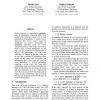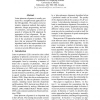ACL
2010
13 years 10 months ago
2010
Existing word similarity measures are not robust to data sparseness since they rely only on the point estimation of words' context profiles obtained from a limited amount of ...
ACL
2010
13 years 10 months ago
2010
We challenge the NLP community to participate in a large-scale, distributed effort to design and build resources for developing and evaluating solutions to new and existing NLP ta...
ACL
2010
13 years 10 months ago
2010
Event extraction is a particularly challenging type of information extraction (IE). Most current event extraction systems rely on local information at the phrase or sentence level...
ACL
2010
13 years 10 months ago
2010
Tree-to-string systems (and their forestbased extensions) have gained steady popularity thanks to their simplicity and efficiency, but there is a major limitation: they are unable...
ACL
2010
13 years 10 months ago
2010
Automated summarization methods can be defined as "language-independent," if they are not based on any languagespecific knowledge. Such methods can be used for multiling...
ACL
2010
13 years 10 months ago
2010
Dominance links were introduced in grammars to model long distance scrambling phenomena, motivating the definition of multiset-valued linear indexed grammars (MLIGs) by Rambow (19...
ACL
2010
13 years 10 months ago
2010
Letter-phoneme alignment is usually generated by a straightforward application of the EM algorithm. We explore several alternative alignment methods that employ phonetics, integer...
ACL
2010
13 years 10 months ago
2010
Automatically identifying the polarity of words is a very important task in Natural Language Processing. It has applications in text classification, text filtering, analysis of pr...
ACL
2010
13 years 10 months ago
2010
This paper proposes an approach to reference resolution in situated dialogues by exploiting extra-linguistic information. Recently, investigations of referential behaviours involv...
ACL
2010
13 years 10 months ago
2010
Strictly Piecewise (SP) languages are a subclass of regular languages which encode certain kinds of long-distance dependencies that are found in natural languages. Like the classe...






